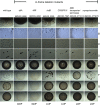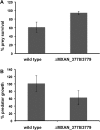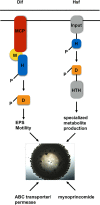Identification of Functions Affecting Predator-Prey Interactions between Myxococcus xanthus and Bacillus subtilis
- PMID: 27698086
- PMCID: PMC5116937
- DOI: 10.1128/JB.00575-16
Identification of Functions Affecting Predator-Prey Interactions between Myxococcus xanthus and Bacillus subtilis
Abstract
Soil bacteria engage each other in competitive and cooperative ways to determine their microenvironments. In this study, we report the identification of a large number of genes required for Myxococcus xanthus to engage Bacillus subtilis in a predator-prey relationship. We generated and tested over 6,000 individual transposon insertion mutants of M. xanthus and found many new factors required to promote efficient predation, including the specialized metabolite myxoprincomide, an ATP-binding cassette (ABC) transporter permease, and a clustered regularly interspaced short palindromic repeat (CRISPR) locus encoding bacterial immunity. We also identified genes known to be involved in predation, including those required for the production of exopolysaccharides and type IV pilus (T4P)-dependent motility, as well as chemosensory and two-component systems. Furthermore, deletion of these genes confirmed their role during predation. Overall, M. xanthus predation appears to be a multifactorial process, with multiple determinants enhancing predation capacity.
Importance: Soil bacteria engage each other in complex environments and utilize multiple traits to ensure survival. Here, we report the identification of multiple traits that enable a common soil organism, Myxococcus xanthus, to prey upon and utilize nutrients from another common soil organism, Bacillus subtilis We mutagenized the predator and carried out a screen to identify genes that were required to either enhance or diminish capacity to consume prey. We identified dozens of genes encoding factors that contribute to the overall repertoire for the predator to successfully engage its prey in the natural environment.
Copyright © 2016, American Society for Microbiology. All Rights Reserved.
Figures




Similar articles
-
Thiocillin contributes to the ecological fitness of Bacillus cereus ATCC 14579 during interspecies interactions with Myxococcus xanthus.Front Microbiol. 2023 Nov 24;14:1295262. doi: 10.3389/fmicb.2023.1295262. eCollection 2023. Front Microbiol. 2023. PMID: 38075900 Free PMC article.
-
A CRISPR with roles in Myxococcus xanthus development and exopolysaccharide production.J Bacteriol. 2014 Dec;196(23):4036-43. doi: 10.1128/JB.02035-14. Epub 2014 Sep 8. J Bacteriol. 2014. PMID: 25201946 Free PMC article.
-
Predation by Myxococcus xanthus induces Bacillus subtilis to form spore-filled megastructures.Appl Environ Microbiol. 2015 Jan;81(1):203-10. doi: 10.1128/AEM.02448-14. Epub 2014 Oct 17. Appl Environ Microbiol. 2015. PMID: 25326308 Free PMC article.
-
The Genetics of Prey Susceptibility to Myxobacterial Predation: A Review, Including an Investigation into Pseudomonas aeruginosa Mutations Affecting Predation by Myxococcus xanthus.Microb Physiol. 2021;31(2):57-66. doi: 10.1159/000515546. Epub 2021 Apr 1. Microb Physiol. 2021. PMID: 33794538 Review.
-
The predatory life cycle of Myxococcus xanthus.Microbiology (Reading). 2016 Jan;162(1):1-11. doi: 10.1099/mic.0.000208. Epub 2015 Oct 30. Microbiology (Reading). 2016. PMID: 26518442 Review.
Cited by
-
Reutericyclin, a specialized metabolite of Limosilactobacillus reuteri, mitigates risperidone-induced weight gain in mice.Gut Microbes. 2025 Dec;17(1):2477819. doi: 10.1080/19490976.2025.2477819. Epub 2025 Apr 7. Gut Microbes. 2025. PMID: 40190120 Free PMC article.
-
Thiocillin contributes to the ecological fitness of Bacillus cereus ATCC 14579 during interspecies interactions with Myxococcus xanthus.Front Microbiol. 2023 Nov 24;14:1295262. doi: 10.3389/fmicb.2023.1295262. eCollection 2023. Front Microbiol. 2023. PMID: 38075900 Free PMC article.
-
Myxococcus xanthus predation: an updated overview.Front Microbiol. 2024 Jan 24;15:1339696. doi: 10.3389/fmicb.2024.1339696. eCollection 2024. Front Microbiol. 2024. PMID: 38328431 Free PMC article. Review.
-
Comparative genomics of Myxococcus and Pyxidicoccus, including the description of four novel species: Myxococcus guangdongensis sp. nov., Myxococcus qinghaiensis sp. nov., Myxococcus dinghuensis sp. nov., and Pyxidicoccus xibeiensis sp. nov.Front Microbiol. 2022 Nov 10;13:995049. doi: 10.3389/fmicb.2022.995049. eCollection 2022. Front Microbiol. 2022. PMID: 36439860 Free PMC article.
-
Functional genomics study of Pseudomonas putida to determine traits associated with avoidance of a myxobacterial predator.Sci Rep. 2021 Aug 12;11(1):16445. doi: 10.1038/s41598-021-96046-8. Sci Rep. 2021. PMID: 34385565 Free PMC article.
References
Publication types
MeSH terms
Substances
LinkOut - more resources
Full Text Sources
Other Literature Sources

